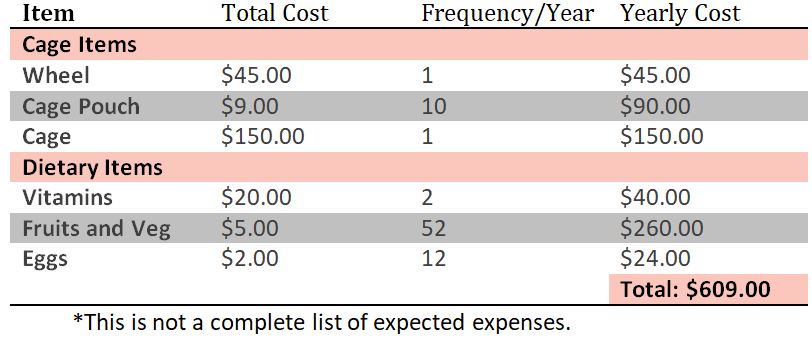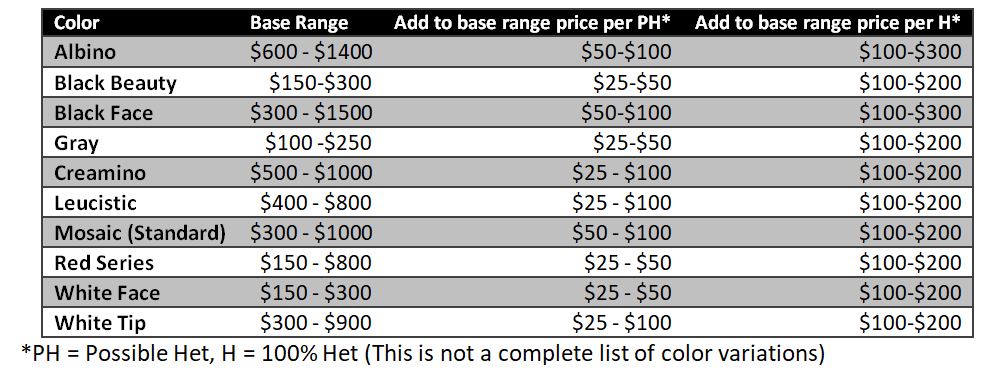How to start breeding sugar gliders
A breeding plan is a written document that outlines your goals for breeding sugar gliders. It helps to organize your ideas and prepare you for a long-term breeding program. This document should include the following:
- Mentor contact information and question list
- Breeding program focus and goals
- Veterinary contact information, budget and expenses
- Care budget and expenses
- Laws and licensing contacts, processes, budget and expenses
- Sugar glider purchasing budget and expenses
- Breeding room layout diagram
- Sugar glider pairings/colony list
- Emergency contacts, care procedures, and vet information
Finding a mentor
A common practice in sugar glider breeding is finding a mentor to help you through your first few years of breeding. A good mentor will help you develop a focus, point you to reputable breeders, sift through pedigrees, set up pairs, and answer questions along the way.
Finding a mentor is generally easy. Visiting Facebook groups or sugar glider forums are good places to find breeders willing to assist new breeders. You can also search for breeders online and asking if they are willing to do a mentorship. Do not be offended if a breeder is unable to do a mentorship, as mentoring is a serious commitment. If possible, find a local mentor. This will allow you to see firsthand a working setup and allow your mentor to help you in person with questions and emergencies.
Do not settle for any mentor. Be sure to ask questions and make sure they are a good fit for you. Mentors should have at least 3-5 years of breeding experience and have similar breeding focuses.
Developing a focus
One of the most important parts of a breeding plan is a clear focus that answers the age old question; why are you breeding sugar gliders? This will help you choose the best sugar gliders for your program. For example, if the main focus for your breeding program is to produce white mosaic joeys with leucistic backgrounds, you will most likely not choose a sugar glider with an albino background and no mosaic coloring. The more specific the focus is for your breeding program, the easier it will be to stay on track.Some breeding programs change focuses over time as the breeder becomes more experienced, while other breeding programs develop more than one focus over time. As a new breeder, it is best to start with one focus. Some common focuses among breeders include:
- Breeding for a specific color, variation or trait
- Breeding to remove/reduce a specific color, variation or trait
- Breeding to combine a series of colors, variations or traits
- Improving or growing lines for a specific color or variation
- Outbreeding a specific color, size, or variation
- Breeding for a specific temperament
- Breeding for a specific size or shape
- Build lines from foundation gliders
Veterinary budget and expenses
All breeding programs need to be prepared for veterinary expenses, both expected and unexpected. Yearly wellness checks, including fecal tests, should be completed on all breeding sugar gliders. Additionally, all new sugar gliders to your breeding program should have a vet check before they are introduced to your sugar glider population to prevent possible contamination of your healthy colony. Emergency injuries, such as mating wounds, can also require veterinary care and should be considered when preparing your budget. To prepare your veterinary budget, consider the size of your colony and expected veterinary expenses. Call your local vet for pricing to get an estimate of wellness checks, fecal exams, and office visits. Use these prices to estimate how much to set aside yearly for expected expenses.
Unfortunately, it is impossible to predict how much money to set aside for emergency visits. Mating wounds, illnesses, and injuries can happen at any time and with any frequency. Many breeders use the same amount they calculated for expected expenses for their emergency veterinary budget calculation. For example, if you expect to spend $500.00 yearly for predictable expenses, your total veterinary fund should be around $1,000.00.
Care budget and expenses
Care expenses include dietary ingredients, proper cages, cage maintenance, toys, stimulation items, and bonding accessories. Calculating this number can be difficult and greatly depends on you as a breeder. Make a list of all your expense. Then, research the costs of those items and the frequency rate at which you will need to buy each item. See the partial example below:

Remember this is a startup care budget as a new breeder. As the years progress, you will need to adjust your projected care expenses. For example, you will most likely not need to replace your sugar gliders cage every year. However, you may find that the diet you initially chose does not fit your sugar gliders’ needs.
Laws and licensing
Breeding sugar glider can be subject to additional laws and may require additional licensing or be banned from specific areas. For example, in Florida sugar glider breeders are required to maintain a license from the Fish and Wildlife Conservation Commission. A small town in Ohio does not allow sugar gliders within township limits. To be sure breeding sugar gliders is legal in your area, check with both local and state bodies. Be sure to ask the following questions:
- Is breeding sugar gliders legal in (area)?
- Is there any additional licensure to legally breed sugar gliders in (area)?
- What is the process to obtain the license?
- How much does the license cost?
- Will the license need renewed and how often?
Be sure that you factor additional licensing expenses and licensing requirements into your breeding plan. Also, include a list of all contacts and discoveries you made while researching the legalities of sugar glider breeding in your area. You may need to reference this information later.
Sugar glider purchasing budget and expenses
You need to determine your budget for purchasing sugar gliders that match your breeding goal(s). To determine the approximate cost of a particular type of sugar glider, search sugar glider ads, visit websites, and speak with breeders. Your mentor will also be able to help you with price range expectations. Be aware that sugar glider prices vary greatly. Generally, the rarer the color, variation or combination, the more expensive the sugar glider will be. Below is a list of approximate prices for some sugar glider variations as of July 2018 based on Internet research.

Breeding room layout diagram
Designing your breeding room is an important step. It will help with organizing your sugar glider equipment and understanding your cage limitations. For example, if you want to breed 4 pairs of sugar gliders, you need to make sure your space is large enough to allow for 4 properly sized cages and their belongings.
You will need to include organizational plans within your layout. This will help stream-line the process of caring for your sugar gliders and aide in emergency situations. Clean pouches and toys, dirty pouches and toys, cage cleaning supplies, treats, paperwork, emergency supplies, and bedding should have a designated area in your diagram. To start your layout, measure your sugar glider space. Then, decide how your cages will be placed in the room. At this point, you probably know the size of the cages you will have. Draw boxes in your layout to represent your cages. Be sure to leave space between cages for sugar glider safety. It may help to number your sugar glider cages for reference later (cage 1 has Bob and Sally in it). Finally, add in your organizational items to your diagram. It may help to take notes on how you plan to store items. For example, if you are going to have a clothes basket for dirty pouches, you may want to note it on your diagram for future reference.
Sugar glider pairings/colony list
After you have located your sugar gliders and know how many cages will work for you, it is time to make a list of your pairings and/or colonies. It is important to note here that colony breeding can be difficult and is not recommended for beginners.
When making your pairing/colony list, it is important to ensure that the pairing/colony will produce joeys that fit your breeding goals and have pedigrees that result in low COIs and high ALCs. Your mentor and/or breeder you are purchasing from will help you with this in most cases. Traditionally, a COI should be lower than 5%. However, in some situations it may be higher.
Emergency contacts, care procedures, and vet information
This last section of your breeding plan is critical to complete prior to breeding. Emergencies will happen; be it a family emergency that takes you away from the care of your sugar gliders or a sugar glider emergency that requires an immediate vet visit late in the evening. When working with live animals, you need to be prepared. Be sure you have the following information written down and displayed clearly in your sugar glider room. This will ensure that anyone can take over your sugar gliders’ care whenever it is needed so you can focus on the emergency at hand.
- A list names, phone numbers, physical addresses, and e-mail addresses of at least 2 people that know about sugar glider care.
- A step by step guide on sugar glider care and feeding procedures:
- Where are the food supplies (bowls, water bottles, etc.), and dietary ingredients to feed your sugar gliders? Example: The sugar gliders’ staple is located in the freezer in an ice cube tray. Fruits and vegetables can be found chopped in the refrigerator and is labeled “glider food”. Sugar glider dishes can be found in the 3rd kitchen cabinet on the 1st shelf. Clean pouches are in the bin marked “clean pouches” in the closet. Extra toys can be found in the bottom drawer located in the sugar glider room. Bedding is located in a tub marked “bedding” in the closet. The treat bin is located on the shelf in the sugar glider room. The emergency kit is on the table located in the sugar glider room.
- How do you feed each cage and how much? Example: Cage 1 gets 2 tablespoons of thawed fruits and vegetables and 1 tablespoon of staple on a plate placed in a glider kitchen at 7pm. Food that is not eaten is removed at 7am.
- When and how do you clean the cage? Example: Trays from cages are removed and cleaned on Tuesday and Friday each week. Remove old bedding and wipe the tray clean with diluted bleach water (50/50 mixture). Replace the bedding and put the tray back in the cage. Dirty pouches are placed in the washing machine washed with 1 cup of vinegar and hung dry on Wednesdays. On Monday, cages and toys are wiped down with a 50/50 mixture of vinegar and water.
- What are your expectations of socialization when you are not around? Example: Check each cage for joeys on Monday. Check pouches for wear every other day when the sugar gliders are awake. Feed each sugar glider a treat from the treat bin every night.
- Emergency veterinarian’s and normal veterinarian’s contact information. Include name, business name, physical address, phone number, e-mail address, and website (if available).